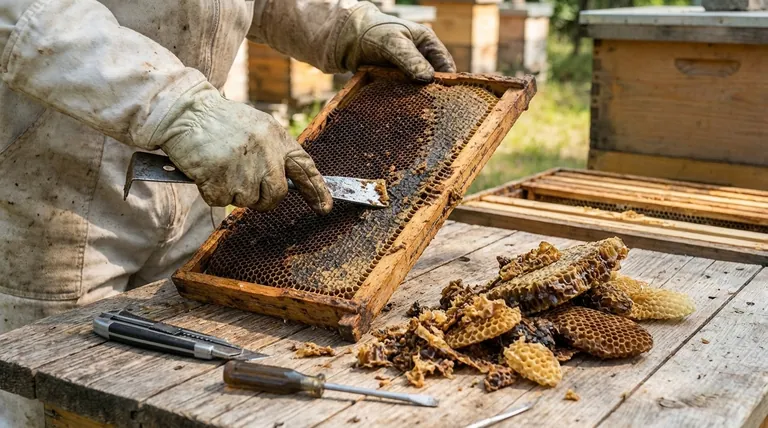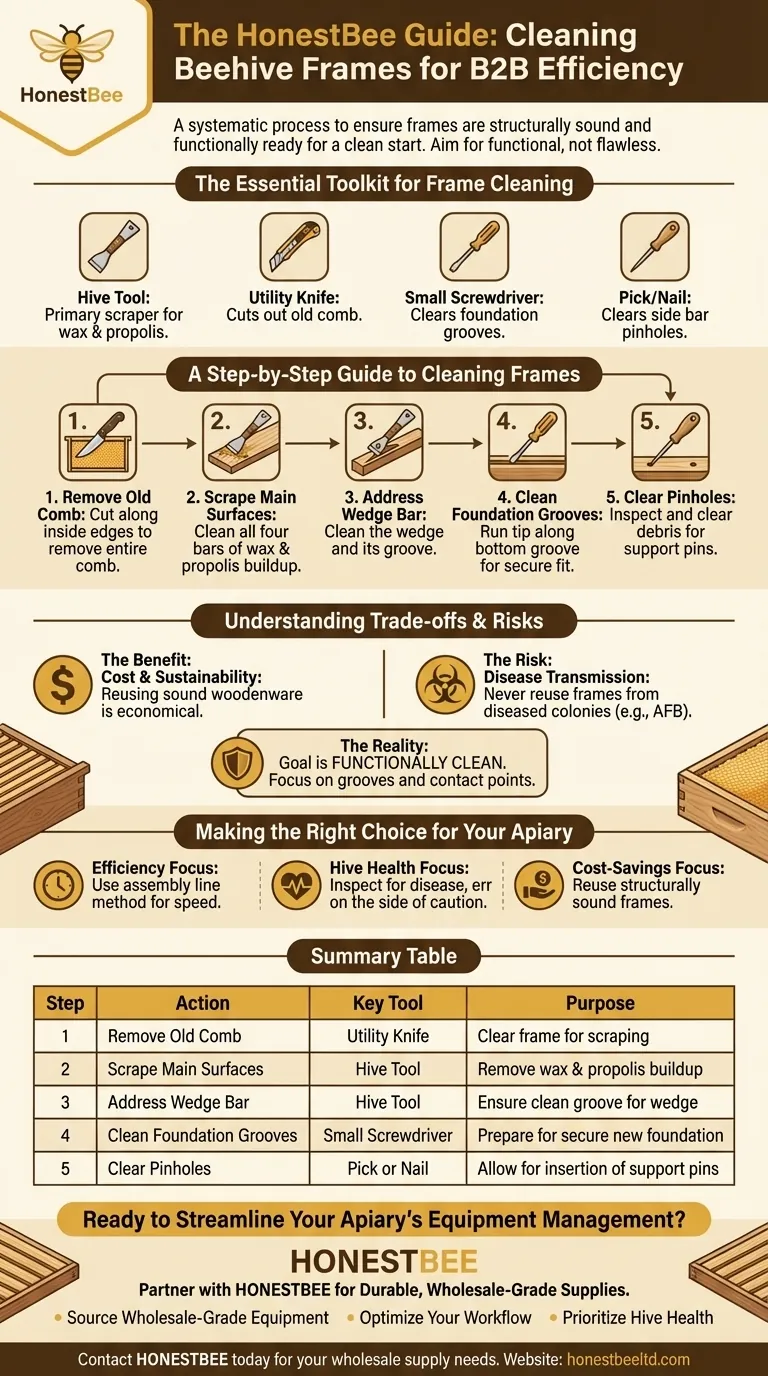Cleaning used beehive frames is a systematic process of removing old comb, wax, and propolis to prepare them for reuse. It involves cutting out the old comb, scraping the wooden surfaces with a hive tool, cleaning the foundation grooves with a small screwdriver, and clearing the side bar pinholes with a pick.
The goal of cleaning frames is not to make them look brand new, but to ensure they are structurally sound and functionally ready to accept a new sheet of foundation, providing a clean start for your bees.

The Essential Toolkit for Frame Cleaning
Before you begin, gathering the right tools will make the process significantly faster and more effective. You likely already have most of these in your beekeeping kit.
The Hive Tool: Your Primary Scraper
Your standard hive tool is the most important item. Its flat, sturdy edge is perfect for scraping away the bulk of wax and propolis stuck to the top, bottom, and side bars of the frame.
The Utility Knife: For Major Comb Removal
A sharp knife is necessary for the first step: cutting the old, drawn-out comb away from the four sides of the frame. A simple utility knife or a dedicated uncapping knife works well.
The Small Screwdriver: For Precision Groove Work
A small, flathead screwdriver is uniquely suited for clearing the narrow foundation groove along the frame's bottom bar. This ensures a new sheet of foundation can be seated properly.
The Pick or Nail: For Clearing Pinholes
To reuse frames that require support pins, you need a pointed tool like a small pick, an awl, or even a thin nail to clear old wax and debris out of the pre-drilled pinholes.
A Step-by-Step Guide to Cleaning Frames
Follow this methodical process to efficiently prepare your frames for their next use in the hive.
Step 1: Remove the Old Comb
Begin by using your knife to cut the old wax comb away from the wooden frame. Cut along the inside edges of the top, bottom, and side bars until the entire comb can be removed in one piece.
Step 2: Scrape the Main Surfaces
With the comb removed, use your hive tool to scrape all four wooden bars. Focus on removing any residual wax, burr comb, and hardened propolis to create a relatively smooth surface.
Step 3: Address the Wedge Bar
On frames with a removable wedge bar (typically along the top), use your hive tool to gently pry it up. Scrape both the wedge piece itself and the groove it sits in to remove any built-up wax.
Step 4: Clean the Foundation Grooves
Use the tip of a small flathead screwdriver to run along the foundation groove in the bottom bar. This is a critical step to ensure your new foundation sheet will slide in and fit securely.
Step 5: Clear the Pinholes
Finally, inspect the small pinholes on the side bars. Use a pick or nail to poke through each hole, clearing any wax or debris that would prevent you from inserting support pins later.
Understanding the Trade-offs and Risks
Cleaning frames is economical, but it's not always the right choice. Knowing when to clean and when to discard is critical for apiary management.
The Benefit: Cost and Sustainability
The primary reason to clean frames is to save money. New frames and foundation are a significant recurring expense for any beekeeper. Reusing sound woodenware is both economical and sustainable.
The Risk: Disease Transmission
Never reuse frames from a colony that died from a known disease, especially American Foulbrood (AFB). Spores can persist on the equipment for decades. Such frames must be burned or disposed of according to local regulations to prevent catastrophic spread.
The Reality: Aim for Functional, Not Flawless
The goal is a functionally clean frame, not a sterile one. Some propolis staining or wax residue is perfectly acceptable. Your focus should be on clearing the grooves and contact points where the new foundation will sit.
Making the Right Choice for Your Apiary
Your approach to frame management should align with your primary goals as a beekeeper.
- If your primary focus is efficiency: Set up an assembly line, completing one step on all frames before moving to the next (e.g., scrape all frames, then clean all grooves).
- If your primary focus is hive health: Always inspect frames for signs of disease or excessive mold before cleaning, and err on the side of caution by discarding any that are suspect.
- If your primary focus is cost-savings: Cleaning structurally sound frames is almost always the most economical choice over purchasing new equipment.
A well-cleaned frame gives your bees the best possible start for drawing fresh, healthy comb.
Summary Table:
| Step | Action | Key Tool | Purpose |
|---|---|---|---|
| 1 | Remove Old Comb | Utility Knife | Clear the frame for scraping |
| 2 | Scrape Main Surfaces | Hive Tool | Remove wax and propolis buildup |
| 3 | Address Wedge Bar | Hive Tool | Ensure a clean groove for the wedge |
| 4 | Clean Foundation Grooves | Small Screwdriver | Prepare for secure new foundation placement |
| 5 | Clear Pinholes | Pick or Nail | Allow for insertion of support pins |
Ready to Streamline Your Apiary's Equipment Management?
For commercial apiaries and beekeeping equipment distributors, efficiently managing frame cleaning and replacement is key to operational success and cost control. HONESTBEE supplies the durable, high-quality beekeeping supplies and equipment you need to maintain a healthy and productive operation.
- Source Wholesale-Grade Equipment: Get the sturdy hive tools, frames, and foundation designed for heavy, repeated use.
- Optimize Your Workflow: Equip your team with the right tools to make frame cleaning and hive maintenance faster and more effective.
- Prioritize Hive Health: Ensure you have a reliable supply of equipment to promptly replace frames from diseased colonies.
Let's discuss your wholesale supply needs. Contact HONESTBEE today to get the reliable equipment that supports your business.
Visual Guide

Related Products
- Wooden Bee Hive Frames for Beekeeping and Wholesale
- Copper Bee Frame Eyelets for Beekeeping
- HONESTBEE Professional Long Handled Hive Tool with Precision Cutting Blade
- HONESTBEE Bee Frame Grooving Machine | Precision Slotting for Bee Frame Making
- Langstroth Honey Bee Box Hive Boxes for Different Depths
People Also Ask
- Will honey bees clean up old frames? A Guide to Safe and Efficient Frame Reuse
- What is the role of oxalic acid in plants? A Key to Plant Defense and Internal Regulation
- What are the primary uses of different Langstroth frame sizes? Optimize Your Hive for Health & Honey
- What are the standard sizes of frames used in Langstroth hives? Choose the Right Frame for Your Apiary
- What color options are available for plastic frames, and what is the benefit of black frames? Boost Your Hive Inspection Efficiency



















